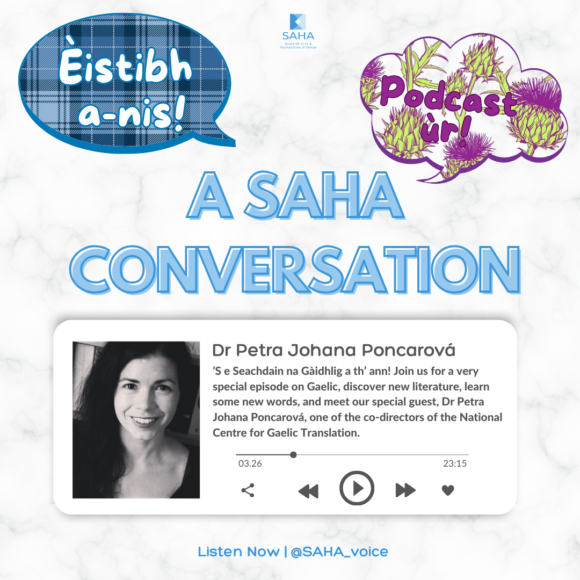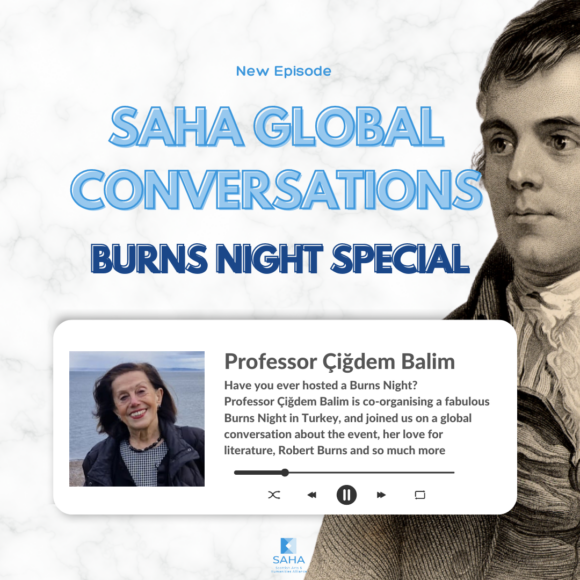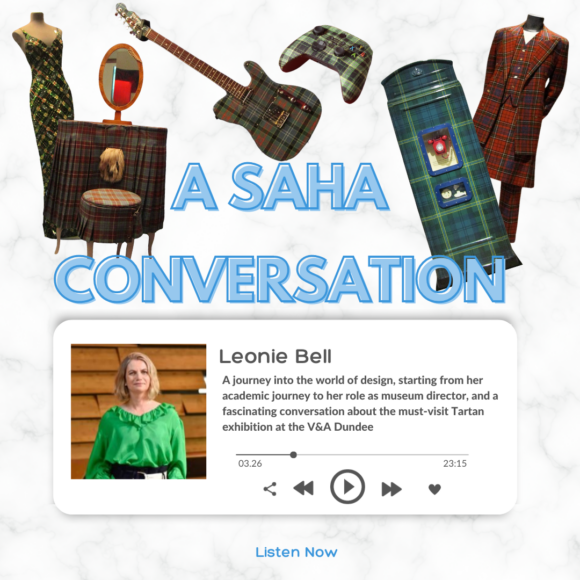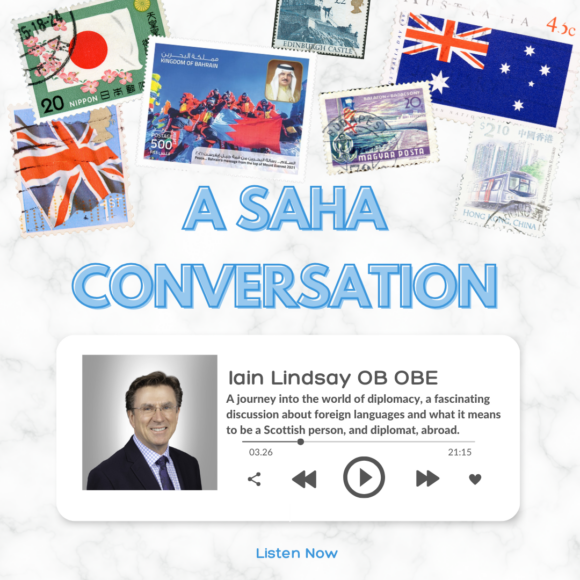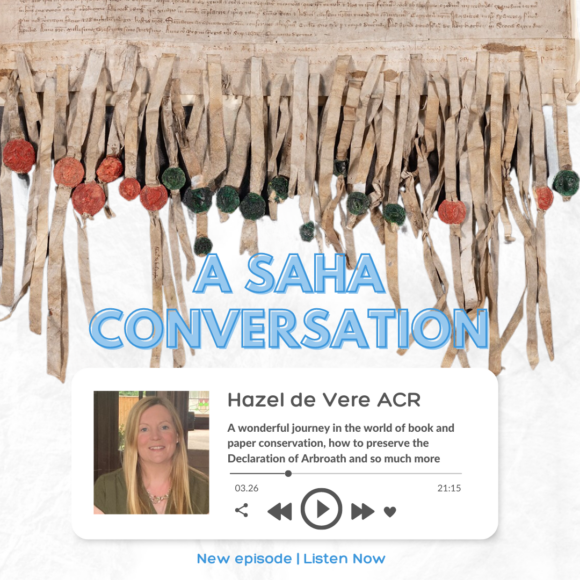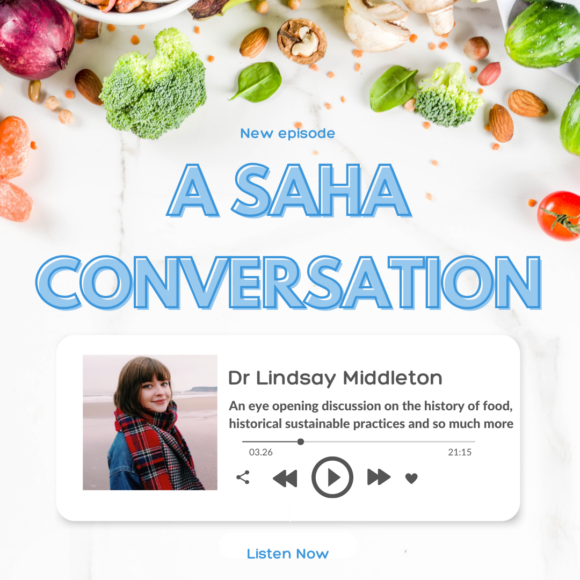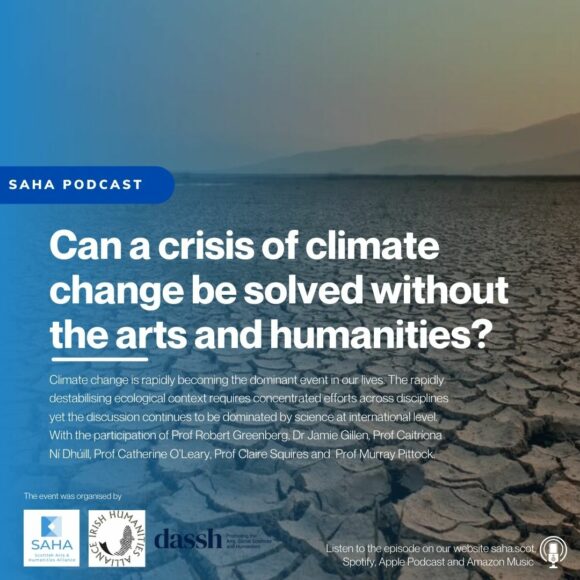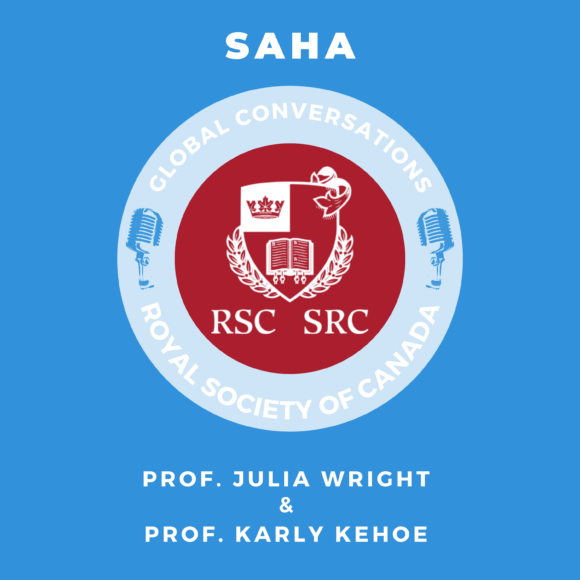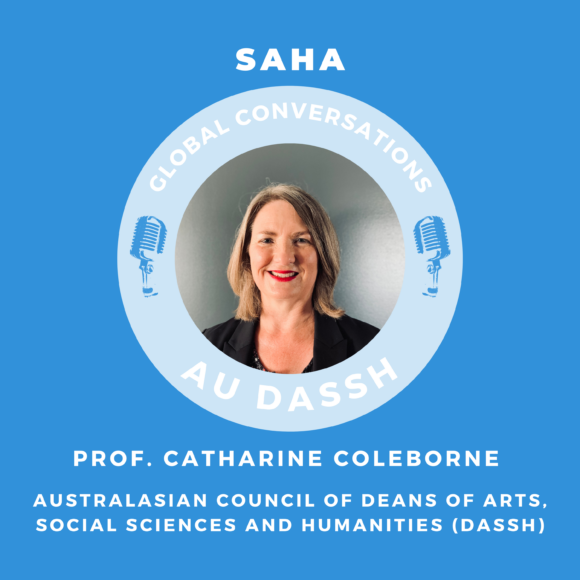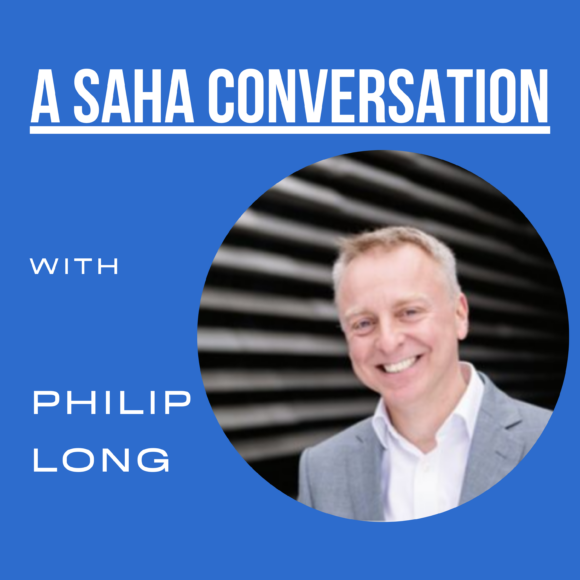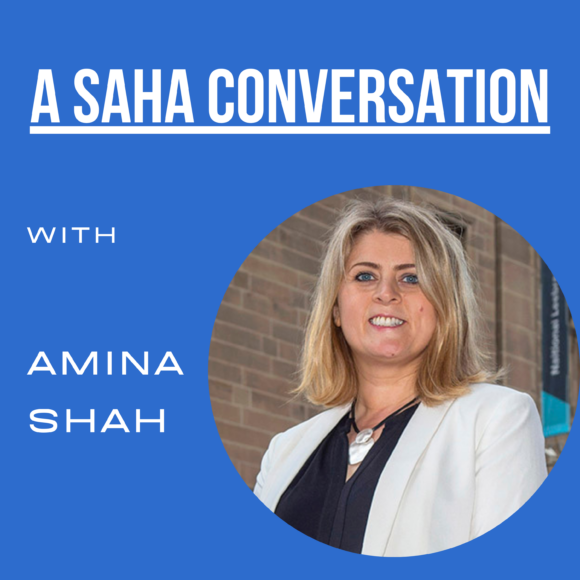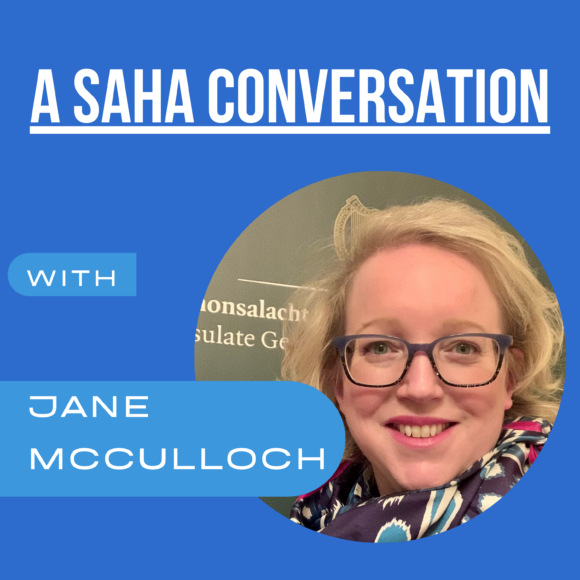It’s that time of the year 🎃 Many people have carved their pumpkins, got their costumes out, made plans to see the fireworks or go trick or treat, and here at SAHA, we’re ready to join the Halloween festivities in our own special way. Join us on a short journey to Ireland together with the Irish Humanities Alliance and talk about the history of Halloween. Welcome to this special episode of SAHA Global Conversations, a podcast by the Scottish Arts and Humanities Alliance. SAHA for short.
Joining us from the Irish Humanities Alliance:
Professor Sonja Tiernan, co-ordinator of the Irish Humanities Alliance based at the Royal Irish Academy in Dublin. Before this, Sonja was the Eamon Cleary Chair of Irish Studies and co-director of the Centre for Irish and Scottish Studies at the University of Otago in New Zealand before returning home to Ireland in April this year. She is a historian of modern Ireland.
Dr Nessa Cronin, Vice-Chair of the Irish Humanities Alliance, and Assistant Professor in Irish Studies at the Centre for Irish Studies, School of Archaeology, Geography and Irish Studies, University of Galway, Ireland. A graduate of Philosophy and Literature, her current research lies in the intersection between Irish Literature, Language and Landscape, with a particular focus on the role of the Environmental Humanities, and Public Humanities more broadly, in addressing the climate and biodiversity crises of this century.
For more information on the Irish Humanities Alliance, visit their website Irishhumanities.com.
If you like this episode, please subscribe, like and share it on your favourite social media.
Happy Halloween 🎃
 Transcript
Transcript
It’s that time of the year. Many people have carved their pumpkins, got their costumes out, made plans to see the fireworks or go trick or treat. And here at SAHA, we’re ready to join the Halloween festivities in our own special way. Join us on a short journey to Ireland together with the Irish Humanities Alliance and talk about the history of Halloween. Welcome to this special episode of SAHA Global Conversations, a podcast by the Scottish Arts and Humanities Alliance. SAHA for short. Joining us from the Irish Humanities Alliance, we have Professor Sonja Tiernan, coordinator of the alliance, currently based at the Royal Irish Academy in Dublin and previously Chair of Irish Studies and Co-Director of the Centre for Irish and Scottish Studies at the University of Otago, New Zealand/Aotearoa and Dr. Nessa Cronin, vice Chair of the Irish Humanities Alliance and currently assistant professor in Irish studies at the University of Galway, Ireland.
Sonja, Nessa, thank you for joining on the SAHA Global Conversation. We are really happy to have you on this episode.
Thanks very much.
So, before we get into the proper Halloween spirit, Sonja, could you please tell us something about the Irish Humanities Alliance?
Certainly. The Irish Humanities Alliance actually celebrates a ten year anniversary this year. So, founded in 2013, the Alliance was established as a joint initiative of humanities researchers within eleven higher education and research institutions, including universities across the all Ireland of Ireland, and the Royal Irish Academy, which hosts the IHA. And we’re delighted to continue our collaborations with SAHA since its establishment, and listeners can find out more about our activities on Irishhumanities.com.
Well, that’s brilliant. Thank you. And happy anniversary to the Irish Humanities Alliance. So, Nessa, I mentioned fireworks in trick or treat earlier, but I’m sure those have not always been a feature of Halloween festivities. It’s a modern version of Halloween, which is, in fact far, far from what it used to be. So some people do closely associate it with the Catholic All Saints Day, which takes place on November 1st. But Halloween has roots in pagan traditions, so can you explain that to us, please?
Yeah, I suppose like anything in Irish history, there’s always a contestation about its origins, but that keeps us all working and guessing about it. So some scholars think that it did originate in pagan, pre-Christian Ireland. Other scholars think that when Christianity came to Ireland, it kind of Christianized what was a pagan festival and kind of made it its own. And then others argue then as well, that maybe it actually is more Christian than pagan. But I think most people out on the streets on the 31st of October really don’t, that doesn’t really matter to them. They’re just out to have fun, play pranks on their neighbour birds, get dressed up, have a bit of the “craic”, as we say here in Ireland, and get nice, tasty treats to eat at home when they go home afterwards. But there are definitely some traditions associated with Halloween that we can see that have a very long history in Ireland, and we can chat a little bit more about those as well in a moment. And I know that Sonja as well has experience of this internationally as well, how these traditions have travelled. And indeed what we experience in Ireland today has come via North America in many ways, as much as from pre-Christian Ireland as well.
As you said, this comes from pre-Christian maybe or maybe it comes from Christianity, but one thing that we all know is that Halloween is supposed to be one of the spookiest days of the year. So there’s a lot of supernatural, there’s a lot of occult in the tradition and in the myth of Halloween. So, I know that there are traditions of, like, leaving a chair next to the fire. This is like some old traditions because you were expecting the spirits of your loved ones coming to visit. Can you tell us something a little bit more of these traditions and if people still remember them or still do them?
Well, absolutely. And I direct our listeners as well to the Irish Folklore Commission archive, it’s housed in UCD, and we can post that link online as well, maybe afterwards. So a lot of these traditions, we have documentary evidence for them from the 19th century that kind of stretches back into earlier oral traditions as well. So ideas of leaving a chair by the fire also, people would have maybe said prayers as well for the dead that had passed and had a meal, a special meal as well, on the 31st of October. And then it was after that, then that parlour games would happen, or the visiting of the neighbours and the kind of other traditions that we would associate with Halloween. So I suppose as well, to remind listeners that one of the names associated with Halloween in Ireland is Samhain, the festival of Samhain, and it’s one of the four quarter days that we have from the Irish traditional calendar. So the first is Imbolc, which is the 1st of February, and then we have Beltane, which is the 1st of May. We have Lughnasadh then in August, and then we have Samhain then. And Samhain is kind of one of these cusp periods where it’s both about celebrating the end of the harvest and kind of welcoming the harvest in, but it’s also anticipating the dark winter months. And then we have that association then of the 1st of November, which is known as All Saints Day or All Souls Day, and that has been Christianized in many ways as well. So we have that overlap between the pagan and the Christian then as well, too. So, like many traditions in Ireland, there’s an overlap of a pre-Christian world with a Christian world. There’s the liminal spaces of the other world with the physical, material world and somehow, happily, we’re all very happy to intersect along those lines on the 31st of October and have a bit of fun along the way.
There’s always so much of Irish folklore that people sometimes tend to forget it. For example, the existence of fairies. Which, I think it’s quite different from the Disney type of fairies. Like, when you say fairy, I think people think something like Tinker Bell, which is Definitely not. For our audience because this is a Global Conversation. Could you please, or maybe Sonja, if you want, could you please tell people what Irish folklore fairies are like?
Well, fairies to us, the way I would say they’re more of a malevolent spirit. Like, if you were to say that somebody was “away with the fairies” generally means that their mind has been taken over, if you like. And we have some of these horrendous stories. Actually, the one that would pop to mind is Bridget Cleary, who was supposedly behaving in a way that wasn’t right for a woman at the time, and her husband and her family decided that she was away with the fairies. So the only way to get rid of this malevolent spirit within her was to set her on fire so she was actually burnt. The burning of Bridget Cleary. And Nessa would probably know more about dates of that, but that’s the kind of idea of, like, fairies possessing people and leading people astray. It’s also the idea even we still have, which actually people will still abide by it, it was a fairy tree that a tree that’s designated a fairy on your fairy tree on your land. You never, ever chop it down because something bad will happen. And we still get articles in newspapers about to this day about some man’s farmland that’s actually now, you know, no use or has turned everything has turned to blight because he chopped a fairy tree down. Are there be issues of roads being built around a fairy tree because you do not mess with the spirits of the fairies.
I’ll just pick up on that. Definitely you don’t mess with the fairies. The fairies are even further divided and categorised into different subgenres or subspecies almost as well. You could take a very scientific approach to them as Yeats actually attempted to do at the end of the 19th century as well, with his Madame Blavatsky circle in London. But the fairies in Ireland and it’s kind of curious because of Walt Disney’s, you know, Irish connections as well, how he kind of created a different kind of Disneyified consumer, kind of more palatable friendly version of the Irish fairy. You have the good fairies and the not so good fairies, and they’re known as the Daoine Maithe, the good people. But they’re good in the way that you have to leave them alone and you have to respect them. And somebody like Angela Burke, whose work Sona there referenced on the burning of Bridget Cleary, Angela Burke and other folklore scholars like who’s a very popular Irish storyteller in Ireland, they’ll always say as well that whether the fairies are there or not. Believe in the fairies or you don’t believe in the fairies, they’re a way for a culture to understand itself. So whether it was issues of postnatal depression, maybe in a woman after giving birth, or maybe infant child mortality rates that were very high in Ireland of the 19th century, or illnesses in a particular illnesses, maybe in your farm that you couldn’t explain, you could always then blame the fairies. So it’s a way for a culture, and lots of native indigenous cultures have other similar ways of processing difficult and traumatic elements, maybe in their culture as well. On the other hand, there are people who really believe the fairies are there. And our Icelandic neighbours as well have also had similar road building issues about elf folk. And I believe, in a recent study, over 36% of Icelanders actually believe that the elves exist. So we’re not on our own in Ireland. But you don’t mess with the fairies. That’s just the general takeaway from this podcast.
So it seems to be that dressing up as a fairy is an actual spooky Halloween costume. It would be perfect for it.
You wouldn’t actually dress up as a fairy. because they might take you away. Nobody’s allowed to be dressed as a fairy anymore. Never, never accept food or water if you go into a fairy fort, or if you go into a fairy area, never accept food or water because that’s your entry point into the fairy world and you will not come back. So there you go. That’s your tip now for Halloween. Yeah, absolutely. I’m just thinking as well, when you’re talking about Disney and fairies, there was I can’t remember whether it was leprechauns or fairies, but Darby O’Gill. Was that fairies? Darby O’Gill and the little people, that was kind of yeah. Leprechauns, kind of yeah. And that kind of brought up that was the Hollywood version, but they were nasty in that. So, listeners, please beware of what you dressed as and beware of kind of food and drink you accept on Halloween. Absolutely.
Speaking on the Irish folklore, I’ve read a really good article on your website, which it will be linked to this episode. So two obvious things stood out for me on this episode, especially how things and traditions and customs have transformed over the years. The first one, which is probably the most obvious one, is food. The sugary treats. Today, they are a staple of the day, even in countries where Halloween is not really a thing. I mean, obviously this is due to marketing rather than folklore and tradition going global, but we do know the importance of food in social gatherings and rituals and secular rituals. And this is still connected to the second thing that stood to me. It’s related to the occult, which. marriage divination that was done through food. So how and why did these, let’s call them sweet traditions start? How did they develop?
I’m not 100% sure about that because I’m not a food historian. But what I would say is that definitely, as you said, the more chocolate sugary treats have really only emerged in Ireland, I would say over the last 20 years or so when I was a child, which wasn’t exactly 100 years ago, but maybe a little bit more than 20 anyway, you might get some small treats, but it was usually fruit. And the big thing as well was chocolate apples. Apples that were kind of coated in chocolate and then covered in other kinds of things. But it was particular fruits and nuts that you’d get at this time of the year. So, again, very harvest type related things. So like hazelnuts, walnuts, things like that might come into the shops and you’d only have them at that time of the year. I suppose the other tradition associated with food in a way then is the turnip and how the turnip would be carved out. And that was the original lantern that now is kind of the pumpkin now has taken over from the turn up in Ireland. But I don’t know if Sonja has any other thoughts on food and that as well
I mean, I do and absolutely, totally agree with Nessa. I mean, certainly when I was a child, we would do that kind of idea of what happens in America, of calling door to door. You would do that, but you’d have in your rhyme, it would be any apples or nuts. It wasn’t sweets. There was no sweets mentioned in it and it would be really rare if you got some. So that has only changed, really, I would agree, in about the last 20 years. But there’s some of the other food traditions that certainly as a child I remember stuck true and that article mentions it as well, about brack and ring being put into the brack and a coin. Now, I think that tradition has kind of gone wayside in some ways, but I think that’s more for health and safety, that if you get a slice of brack and you’ve got a cheap ring in it and you swallow it. But it was that idea, and I can remember that even as a very young child, if you got the ring, that meant you were the next to get married, and you could probably be about seven at the time, and you’re thinking or that you were in for a fortuitous year if you got the coin in the brack. So that tradition kept going all the way through. And I certainly know some people who would bake a brack for Halloween and would put things into it, possibly less in store bought brack that you would get, something like that, I think. But yeah, those traditions are there and the Jack O’Lantern as well. That idea of the turnip. Yeah. It’s moved on, I suppose, to Pumpkin as well, because it changed when the Irish emigrated to especially America, that it was going with the harvest and it had to be. It had to be pumpkin rather than turnip. But I think it’s probably changed in modern day in Ireland as well, because have you ever tried to carve the inside of a pumpkin out? I mean, it would not be that easy. So it’s considerably easier to use a pumpkin. So that’s part of it, and possibly looked more appealing because the original Jack O’Lanterns were very frightening symbols. Like you can get images of them and they’re very scary. And although the pumpkins are kind of carved with those scary images, sometimes it’s not in the same way. I mean, it nearly looks like a death mask or something, the original ones. So you can see why it’s kind of progressed onwards, I think, as well. Sonja that’s a really good point, actually, because if you look at a National Museum of Country Life in Turlock House in Mayo, they have a great website and we can put a link up for that afterwards as well. The old kind of masks that people wore, and they have old kind of jacko lanterns as well. They look very scary and I suppose it shows as well how that transition has happened from what it was not to say originally, because tradition has always been reinvented anyway, but how it has changed, particularly over the latter period of the 20th century. And also, I suppose it kind of is an indicator too, of people going into the darker months of the winter pre, before electrification in Ireland, it was a scary time you know and for children, your imagination would run riot. And also a very strong belief in the afterlife and a very strong belief in the otherworld, which came at this particular time, at this liminal time and space in Ireland. On the 31st of October, the other world of the dead spirits were coming back to visit the homes of their families, but also the fairies were out and about as well, so they were also kind of you might bump into them on the road as well on your travels. So it was genuinely a scary time. So how that has been reframed and repackaged, I suppose, is interesting from a popular culture point of view too.
We mentioned Jack O’lantern very often so far, and I think this is mostly not specifically here and in Ireland, but just the collective imagery would be what you see in the American movies. So you see the nice pumpkin and then the neighbours having sort of wars or feud on who can carve the pumpkin in the nicest way. And I think nowadays most any pinterest board or mostly any neighbour who actually cares about the outside decor has some sort of pumpkin, whether they actually carved it or it’s a store bought plastic one. But as you both mentioned, they used to be made out of turnips and they were scary and they were mentioning or like a reminder of the story of Jack O’Lantern. Can we just quickly talk about this story because not everyone might be familiar with it.
Yeah, I can give you a little overview of this one but I suppose it’s disputed in many of these kind of histories of things that have happened but it seems to have come from 18th century tale. So as far back as that, based on this mean spirited blacksmith whose nickname was Jack. Stingy Jack. And he encountered, seemingly an angel or an old man on the road one day who turned into an angel and granted him wishes. But there were very mean spirited wishes, so the angel granted them, but barred him from heaven. And then the story goes on that then the Devil sent for him to Hell, but he tricked the Devil and then was barred from Hell. So he ends up in some kind of purgatory, just roaming the earth because he’s barred from Heaven and Hell and he has the lantern to accompany him. That some would say the tale is that it’s lit from the ember from hell so that he’s wandering, destined for the rest of eternity to wander with this lantern. But in other ways. I don’t know. There’s so many. Different kind of ideas then of whether the Jack O’Lantern started and then it turned into this story you know it’s very difficult to know because on the other side like Nessa mentioned that it’s such a dark time it’s such a scary time. And the idea to be able to carry a lantern, of course, was helpful. If you were out and about, and especially if people were celebrating. And then the fact that people were wearing masks, it stands to reason that you would then carve something similar into the turnip. But that’s the story of Jack O’Lantern anyway himself, who could be wandering. So along with the fairies, you’ve got to watch out for Jack as well. In neither stories, both fairies and Jack O’Lantern do not really seem to be very child friendly, I want to say. Well, nowadays Halloween is primarily something for kids mostly because of all the chocolate and all the fun imagery but so far we haven’t really seen anything that is so fun and kids friendly.
So since this is the global conversations, let’s talk a little bit about Halloween in other parts of the world. Sonja, you lived in is it New Zealand? You’ve been there for quite some time. How is Halloween there?
I mean, I was quite surprised because you do think that I had actually lived in the UK previously to that as well. And Halloween wouldn’t be celebrated as hugely as you think, because they have Guy Fawkes Day on the 5th of November. So they seem to be more about those kind of events associated around the bonfires and the burning of Guy Fawkes, but we won’t get into that’s. an entirely different podcast on that one. So they don’t celebrate Halloween as hugely as it would be in Ireland or Scotland or America, but in New Zealand they do. And again, it depends on the part of New Zealand that you’re in. I was based in Dunedin, which was actually a city founded by the Scottish, and there was also a huge influx of Irish immigrants there as well. So Halloween would have been celebrated, but not hugely, because you’ve got lower populations, I suppose, as well. But since the 1990s especially, there’s been a huge build up in celebration, and they do very similar things there’s dressing up, the children will go round trick or treating, there’ll be pumpkins carved, there’ll be bonfires. But what’s really unusual about it is that it’s in the springtime. So I found this very unusual that you’ve got even the children after school, it’s not dark. By 10:00 they’re in bed and it’s not dark, so it’s a very unusual so there’s no link to the idea of the harvest time or the seasonal thing, because New Zealand is, of course, totally on the opposite seasons than we are on this side of the world. So that was quite interesting. The other interesting aspect of that is that they assumed in New Zealand that actually the festival had come from America and were really quite surprised that it was any Celtic connections. And so it had lost the historical significance, I think, altogether. But, yeah, well celebrated there, I can add, as well. Before I moved back to Ireland to do my PhD, I worked for two years in Southeast Asia and I was completely thrown by the very vigorous celebration of Halloween in Taiwan and in Laos and in other places as well. So I was teaching there for a few years, and again, as Sonja said, they just saw it as an expression of American culture and just kind of a really fun feast day. And of course, in many of those countries, and particularly in Taiwan as well, there’s a huge overlap of different religious and spiritual traditions. And they actually got very clearly the idea of offering food, of spirits, walking around with the dead and the undead. They got that implicitly because of their own religious traditions as well. So when I was talking to my students and explained Samhain said there, that it was originally originated from this part of the world, they were utterly fascinated by it and a bit confused, used. But then once I explained how the tradition originated, they were like, well, that makes total sense. What we do in our traditions and food offerings and light, and also leaving a door open at a particular day in the year to let the spirits of the past, ones of your family that who are deceased now come back and return, had a huge resonance there. So I think maybe that’s one of the reasons as well, why it’s so popular internationally. It allows maybe some cultures to express something about those who have gone before, that maybe their cultures maybe don’t permit that in the contemporary world as much anymore. We still celebrate those kinds of things in Ireland in different ways, maybe more than other cultures as well. I think you both brought a really good point there, that some people, sometimes they just think it’s an American tradition. I think this idea, which obviously comes from all the mainstream media, is just so ingrained in little kids like Halloween, sweeties, and makes everyone happy. But how is it now in Ireland? Because you’re both based in Ireland now. Sonja, you’re in Dublin, if I remember correctly, and Nessa, where are you now, if we can say that? Yeah, I’m in Galway. I’m in the opposite coast. Yeah. So how would you celebrate Halloween there now? the kids get chocolate or do they get a turnip? Yeah, well, I could certainly say in Dublin, I don’t know what’s happening in Galway, but the fireworks have been going off every night, which is pretty disturbing when you’ve got a newborn baby, woke it up with them and setting the dogs a bit crazy. So the preparations for Halloween there is a big build up, and the fireworks start as if people are just kind of practising for the night. And bonfires are already being started up as well in some areas, because there will be bonfires in certain areas, but quite a lot of it actually, they’ve kind of gone through different waves. I think in Ireland that now it’s getting to the stage where there’s kind of more community events around a bonfire so that they’re properly policed, and I mean by parents, by adults being there, rather than turning into something dangerous, where children in the past had been losing fingers to fireworks, horrendous, things happening like that. But there will be we’ve already kind of started stocking up on the treats in the house because there will be a barrage of children calling, which is actually lovely because you’ll get all the children from the area that will call around and there’s the big kind of show of what they’ve dressed up as and how excited they get, so all of those things will happen. I think there’s less kind of idea of like we always had a traditional dinner on Halloween when I was a child, so there was always called canon, there was always back. I think that’s less and less happening, but maybe something I’ll start up in my own house again this year, who knows? Yeah, the same with us as well as in Dublin, so fireworks, which are technically, I think, illegal in Ireland, but somehow they proliferate this time of the year. So, again, that kind of liminal space that we’re quite comfortable at operating that. And there’s often, again, local bonfires as well. And again, it’s about that idea of light and darkness as well, and inviting other kinds of ways of living and being at the same time, which I find utterly fascinating. In our area, we just live outside of Galway City and we arrange to meet at the crossroads and all the local families meet there and then we go down one side of the road where there’s all the houses and we walk back up the other. The kids have all of their bags ready to collect all of their treats. When I was younger as well, and this annoys all the local kids that come to our house. We always had to do a performance or do something to deserve the treat, or sometimes it was pennies or money that we got as well. And so you always had to sing a song, recite a poem, do a dance or do something, but maybe that was just my quirky Cork childhood, I’m not sure. So I ask kids, when they call to us, I ask them to do that and they’re like looking at me going, what? And they’re like, Just give us the chocolate. And I was like, Give me a recitation, what is it? Doesn’t have to be Robert Emmett on the dock or anything, but that would be good too. And I asked him, Just tell me a joke or sing a song or do something, and they get into it then and they have a bit of fun, which is great. So there’s definitely that community activity and community spirit is definitely there and people love the opportunity to do that and to meet neighbours again. And then in certain communities, then you might all convene in one person’s house or another person’s house. The kids will all tumble out all their goodies on the floor and they might share a few extra ones and then there might be a few drinks with the neighbours and things like that. And we do the barmbrack as well, without choking anybody, and we do the colcannon as well, so that might be one for you, Sonja, this year. Well, that sounds fun and very much fairy free, which is good.
Thank you very much for joining us on this global conversation. This has been a lot of fun and we wish all of our audience happy and safe Halloween without the fairies, without Jack O’Lantern, and without any other monsters. Thank you for joining us.
Thanks, a million. Thank you. Take care. Thanks. Bye.
Thank you for joining us on this SAHA conversation. We hope you enjoyed it and learned something new. If you liked this episode, please share it, subscribe and leave us a like on Twitter and Instagram at SAHA_voice and on Facebook at Scottish Arts and Humanities Alliance.
